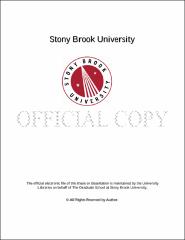| dc.identifier.uri | http://hdl.handle.net/11401/76491 | |
| dc.description.sponsorship | This work is sponsored by the Stony Brook University Graduate School in compliance with the requirements for completion of degree. | en_US |
| dc.format | Monograph | |
| dc.format.medium | Electronic Resource | en_US |
| dc.language.iso | en_US | |
| dc.publisher | The Graduate School, Stony Brook University: Stony Brook, NY. | |
| dc.type | Dissertation | |
| dcterms.abstract | DNA replication occurs once every cell cycle in normal cells and it is a tightly controlled process that ensures complete duplication of the genome. Perturbations in DNA replication may cause catastrophic consequences for the cell including compromised cell proliferation, genomic instability, or cancer susceptibility. The origin recognition complex (ORC) plays a key role during the initiation of DNA replication. I have studied the dynamics of ORC in human cells throughout the cell division cycle to better understand its function in replication initiation. In human cells, the largest subunit of ORC, Orc1 is regulated during the cell cycle. During early S phase it is ubiquitinated and targeted for destruction. New synthesized Orc1 localizes to chromatin during M phase and during late G1 phase is sequentially lost from chromatin, remaining longest on chromatin that is normally late replicating. Orc1 also shows distinctly tight chromatin binding dynamics compared to other ORC subunits. Depletion of Orc1 causes concomitant loss of Mcm3 on chromatin. Together these results suggest that Orc1 acts as pioneer factor by localizing to chromatin during M phase, showing dynamic localization during G1 and recruiting other pre-RC components to chromatin as cell progress through G1. The data suggest that gradual removal of Orc1 from chromatin in late G1 phase may reflect the temporal pattern of DNA replication in S phase. | |
| dcterms.available | 2017-09-20T16:50:25Z | |
| dcterms.contributor | Stillman, Bruce W. | en_US |
| dcterms.contributor | Spector, David | en_US |
| dcterms.contributor | Leatherwood, Janet | en_US |
| dcterms.contributor | Stenlund, Arne | en_US |
| dcterms.contributor | Pappin, Darryl. | en_US |
| dcterms.creator | Kara, Nihan | |
| dcterms.dateAccepted | 2017-09-20T16:50:25Z | |
| dcterms.dateSubmitted | 2017-09-20T16:50:25Z | |
| dcterms.description | Department of Molecular and Cellular Biology. | en_US |
| dcterms.extent | 133 pg. | en_US |
| dcterms.format | Monograph | |
| dcterms.format | Application/PDF | en_US |
| dcterms.identifier | http://hdl.handle.net/11401/76491 | |
| dcterms.issued | 2015-08-01 | |
| dcterms.language | en_US | |
| dcterms.provenance | Made available in DSpace on 2017-09-20T16:50:25Z (GMT). No. of bitstreams: 1
Kara_grad.sunysb_0771E_11845.pdf: 45511751 bytes, checksum: 28d0aca9c6c310b0ce09e1943307b780 (MD5)
Previous issue date: 2014 | en |
| dcterms.publisher | The Graduate School, Stony Brook University: Stony Brook, NY. | |
| dcterms.subject | Molecular biology | |
| dcterms.subject | DNA Replication, ORC, Orc1, Origin Recognition Complex | |
| dcterms.title | Dynamics of Human Origin Recognition Complex During the Cell Division Cycle | |
| dcterms.type | Dissertation | |

